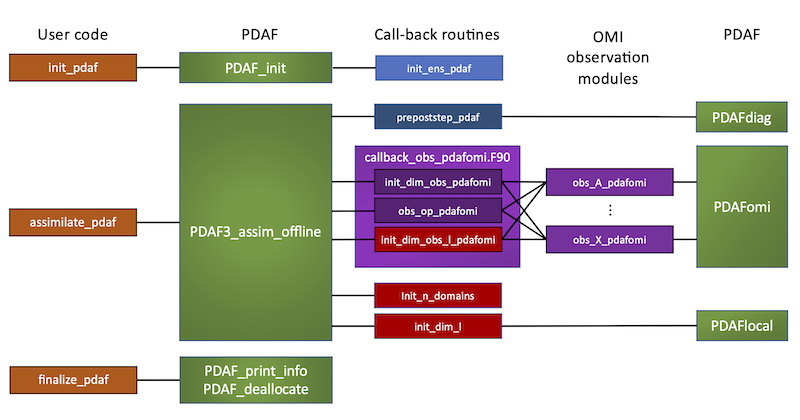Offline Mode: Implementation Guide
| This is an outdated page probably reached through an outdated link. The correct page is likely: * For PDAF3: OfflineImplementationGuide_PDAF3 * For PDAF2: OfflineImplementationGuide_PDAF23 |
Offline Mode: Implementation Guide
This page contains the Implementation Guide for the offline mode of PDAF. For the online mode, which uses a direct coupling of the model and PDAF, see the Implementation Guide for the Online Mode. The differences between the online and offline modes is described on the page on the Implementation concept of PDAF.
The implementation of PDAF in offline mode
For the offline mode of data assimilation, the ensemble integrations by the numerical model are executed separately from the assimilation program, which computes the analysis step. Thus, the model code can remain unchanged in the offline mode. The calls to functions of PDAF are only contained in the assimilation program.
An example of the implementation is given in the tutorial provided with PDAF in tutorial/offline_2D_serial (or tutorial/offline 2D_parallel for a parallelized case). These examples base on the template code at templates/offline. Several subroutines that contain specific operations for the model and observations are called by PDAF through its defined interface as call-back routines. These subroutines need to be implemented by the user. The operations in all these subroutines are rather elementary like filling the array of the ensemble of model states from model output files and the initialization of the vector of observations. The tutorial code includes examples for these routines for a simple case.
We recommend to base your own implementation on the tutorial example or the template by adding to or adapting the functionality, and adding reading and writing routines for model files.
Figure 1 provides an overview of the call structure of the offline code.

Figure 1: Overall call structure in PDAF's offline mode.
The code structure is as follows from left to right
- column 1 'User code': The main program calls the four routines shown in this column. These are interface routines, which define variables for PDAF and then call core-subroutines of PDAF. An exception is
init_parallel_pdafwhich does not call PDAF. - column 2 'PDAF': These are the PDAF core routines which are called by the routines in column 1 to the left.
- column 3 'Call-back routines': This column shows the call-back routines, which are called by the PDAF routines in column 2 to the left. The routines in the purple box
callback_obs_pdafomi.F90are the subroutines that handle observations. The 3 routines in red are used only for localized ensemble filters. - column 4 'OMI observation modules': This column shows observation modules that are used for the specific handling of each observation type. This handling is arranged by the PDAF Observation Module Interface (OMI). The observation-related call-back routines in column 3 to the left call routines in each of the observation modules.
- column 5 'PDAF': Some of the call-back routines and the routines in the observation modules call PDAF core routines, e.g. for diagnostics, localization, and to intialize OMI.
The implementation of the assimilation program for PDAF in offline mode can be performed in following the four routines in the leftmost column:
- init_parallel_pdaf: Initializing the parallelization
- init_pdaf: Initializing PDAF and the ensemble by PDAF_init
- assimilate_pdaf: Implementing the analysis step
- finalize_pdaf: Adding memory and timing information
The name of PDAF core routines always starts with PDAF. The subroutines with name ending _pdaf are generally user-supplied routines in the tutorial codes.
Generating initial ensembles
To perform ensemble data assimilation one has to create an initial ensemble, which is then used in the data assimilation process. There are various different ways to generate an ensemble (like random picking of model states, breeding, short-term integrations of perturbed model fields, second-order exact sampling from EOFs). PDAF provides routines to use snapshots from a model integration to first compute EOFs (empirical orthogonal functions) and then to use the EOFs to perform a constrained random transformation to obtain ensemble perturbations to which a central state (i.e. ensemble mean) is added. This second-order exact sampling (Pham, 2001) showed good performance in our own data assimilation applications.
The ensemble generation is described on the separate page:
